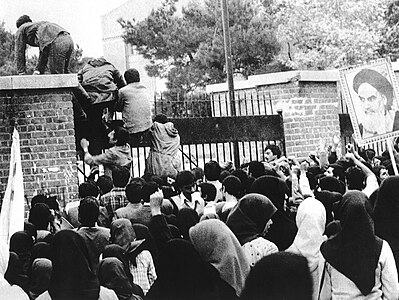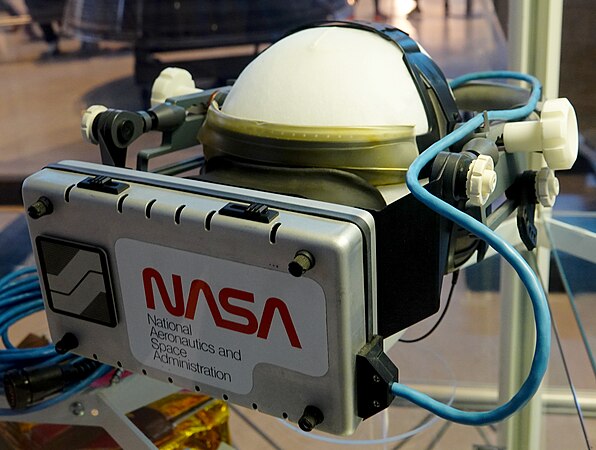US History/Ford Carter Reagan
Introduction: The "New Right", Conservatism, and Demographic Shifts
[edit | edit source]The New Right
[edit | edit source]Ever since the 1964 election, in which the conservative Barry Goldwater failed to defeat incumbent Lyndon B. Johnson, a grassroots (beginning on the local level) movement among other conservatives began growing. Slowly, a group of conservatives began changing their policies and marketing strategies until finally, President Reagan (the culmination of this movement) was elected in 1980. And so, the product of this reformation of the right wing of the political spectrum (the conservative side), became known as the New Right.
This new breed of conservatism emphasized, above all, "smaller" government. This entailed lowering taxes as a catalyst for increased consumer spending, and thus economic growth, at the cost of cutting governmental programs and welfare. Conservative economists pushed "supply side economics" and openly advocated doing away with the tax-funded welfare state created mostly by the New Deal reforms of the 40s in order to keep more money in the hands of consumers instead of the coffers of welfare programs. Additionally, while Goldwater openly opposed the involvement of religion in politics, Reagan ushered in a generation of evangelical Christian activists along with the New Right. During the 1980 election, Reagan openly expressed his commitment to his religion, and during his presidency spoke out strongly against abortion and in support of other issues dear to the religious. The New Right conservatives also notably supported a more hawkish, aggressive foreign policy in the face of communism. They mostly did away with Nixon's detente strategy in favor of a more threatening American world presence.
Sun Belt
[edit | edit source]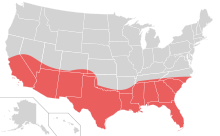
Meanwhile, a band of states in the south and southwest (called the "Sun Belt" because of their sunny climates) had been, since the 50s, experiencing growth that far outpaced the rest of the country. A number of factors contributed to this rapid relative growth. Southern states such as Florida and Texas and areas in the southwest such as southern California, Arizona, and New Mexico had year-round warm, sunny climates and large expanses of flat land suitable for building long tracts of suburban housing. With the widespread adoption of air conditioning by the 1950s, new housing in warm Sunbelt suburbs attracted those living in more seasonably cold climates, and in particular the Northeast. Retirement in the Sunbelt was also an attractive prospect to many of the elderly, and places such as southern Florida became popular places for retirees to relocate.
White Flight
[edit | edit source]Simultaneously, the racially-charged phenomenon known as "white flight" was underway by the 1950s as an indirect result of court decisions (specifically Brown v. Board) and new laws encouraging the desegregation of urban neighborhoods. As blacks moved into predominantly white urban neighborhoods, white families, sometimes worried that as a result of desegregation property values would fall, would put their houses up for sale and move to the suburbs, which were often quieter, safer, and demographically whiter than inner cities. This contributed to the construction of suburbs around major Sunbelt cities such as Los Angeles, Phoenix, Miami, Tampa, Orlando, Atlanta, Houston, and Dallas in the 50s, 60s and 70s. Many families fleeing northern inner cities would eventually settle in these new suburbs.
Car Culture
[edit | edit source]
At the same time, the construction of long-distance, high-speed, high-capacity, limited-access roadways, such as those built as a part of Eisenhower's Interstate highway system, facilitated a lifestyle more dependent on the automobile--that is, it became practical and economical for most members of the workforce to live farther away from their jobs than they had ever lived.[1][2] Whereas earlier in the century the norm had often been for workers to live near their jobs in cities and take a relatively short drive, ride public transportation, or even walk to work, in the second half of the century it became far more common to live in suburbs miles away from jobs (which often remained in dense urban areas) because expressways and inexpensive gasoline facilitated much longer commutes. As suburbs grew, so did American oil consumption. Traffic, environmental, and indirect health problems often arose as suburbs grew beyond the capacity of the infrastructure already in place. This trend would have important bearings on U.S. energy and environmental policy in the 70s and in the new millennium.
Demographics
[edit | edit source]Importantly, some Sunbelt growth was also attributed to immigration from Mexico, and in places like southern California tensions would flare over the employment and taxpayer-funded welfare of illegal immigrants. Southern Florida's growth in the 70s and 80s also had a notable component of immigrants from Cuba, which fell to communism in 1959.
California experienced the greatest growth and surpassed New York as the most populous state, as did Texas (which became the second most populous state). Florida also exhibited very rapid growth. The Sun Belt was (and still generally is, with the notable exception of California and to a lesser extent Florida) committed to conservatism, and in part contributed to Nixon's and Reagan's electoral successes. The growth of this region was at the expense of the Northern cities. The effects of this period on cities are discussed in the final section of this chapter.
Other important demographic shifts were taking place during this period as well. Beginning in the early 60s, fertility rates began a sharp decline from an average of almost four children per family in the late 50s to an average of less than two by the 70s, signaling the end of the post-war baby boom and the birth of what is widely known as "Generation X," the generation that came of age during the 80s and early 90s. This relative drop in fertility rates would later have extremely important repercussions for Social Security, Medicare, and the U.S. health care system as a whole.
Ford and Rockefeller
[edit | edit source]
The world watched as Gerald Ford turned back towards the White House after seeing off former President Nixon in his helicopter. There, he took the oath of office and became the thirty eighth president of the United States. Washington was relieved to put the Watergate crisis behind it. He appointed Nelson Rockefeller, a popular Republican and the former governor of New York, as his Vice President. Many were excited of what would come of Ford's presidency.
Controversy
[edit | edit source]One of Ford's first acts in office would stun the nation.[3] Using executive powers granted to him by the Constitution, Ford granted Nixon a pardon, on September 8, 1974, for any misconduct he may have exhibited as president. Even though Ford fiercely defended his actions, he never regained the popularity that he had in his first days in office. Many believed that Nixon and Ford had worked out a bargain in advance, with Nixon's resignation in exchange for a pardon from Ford.
Later that year, it was leaked to the American public that the CIA had been spying and keeping secret files on legitimate American citizens. Months later, it was leaked that the FBI was doing the same thing. Ford appointed a commission to investigate the inner workings of the two agencies. He, with the help of Congress, passed legislation to keep the agencies in check.
After recovering some trust, the President would again stir up controversy. He offered amnesty, or protection from the law, to those who had avoided the draft or deserted during the Vietnam War. While many approved, others did not, believing that the policy was far too lenient; after all, their loved ones had obeyed the law.
Foreign Affairs
[edit | edit source]
Ford did not have major diplomatic experience, so he relied on Kissinger, who continued Nixon's policies. In 1974, Ford met with Brezhnev to again discuss nuclear weapons. In July 1975, Ford signed the Helsinki Accords, a pledge between the western world and the Soviet Union to respect human rights. Ford also continued to work with China. The Chinese communist leader, Mao Zedong, died in 1976, and a more moderate, centrist government came to power. As a result, the U.S. and China continued to move closer. Ford’s main issues during his presidency were the North Vietnamese victory over South Vietnam (1975), the Mayaguez Incident, Detente and human rights policy, the Middle East crisis, Arab oil power, and the first international economic summits. His actions to re-assert U.S. ability and prestige following the collapse of Cambodia and the humiliating Fall of Saigon in South Vietnam were energetic. On May 12, 1975, the American Merchant Marine ship, S.S. Mayaguez, with 39 crewmen aboard, was captured in international waters by Cambodian gunboats. The ship was retrieved and all crewmen were saved, but at the cost of 41 American servicemen's lives.
Recession and Inflation
[edit | edit source]As the 1970s progressed, it seemed that Europe and Japan might pass the United States in economic power. Japanese cars were popular throughout the nation and European made goods were strong competition to American made goods. Many factories were forced to close, and soon, many Americans were unemployed or underemployed, that is, when one works in a job for which he is overqualified. Another contributing factor to the economic hardships were the actions of the middle-eastern OPEC (Organization of Petroleum Exporting Countries). Even though the oil shortage had been for the most part resolved, OPEC kept its prices high, and the high prices led to inflation (the loss of value of a currency).
To help to reduce inflation, Ford launched Whip Inflation Now (WIN), which promoted the saving of money and advised people to grow their own vegetable gardens in an effort to avoid high food prices. The program led to a small but insignificant drop in inflation; the economy was still plunging into recession. Ford also tried to control inflation by cutting government spending. He vetoed many appropriations bills from Congress that allowed for more spending.
To stimulate the economy, Ford pressed Congress to pass a tax cut, believing that with the extra money saved on taxes, Americans might spend more money. Ford was right, but with less tax revenue, the federal deficit widened. Despite the things he tried, he could not make the economy recover.
1976 Election
[edit | edit source]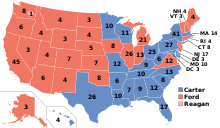
In November 1975, Ford again was determined to win single handedly, noted that he would be competing in every primary. He vowed to, “go right down to the wire in the convention in Kansas City and win there.” Ford was treated as a joke, just as Tom Branden had pointed out, that when "the nation’s end men begin to treat a serious politician as a joke, he is though.” It all began during his trip to Australia in the Spring of 1975, Ford slipped on a rain-slickened ramp while getting off a plane in Salzburg and fell on the stairs. This incident happened in front of various cameramen and reporters, which meant it happened in front of the entire world. Instead of his presidency, Ford became famous for his social blunders, whether they were authentic or fabricated.So going into the 1976 election Ford hoped that, as the incumbent, he would win the election despite his past.
Americans had not quite forgotten about the Watergate crisis and Ford's subsequent actions, though. The Watergate Scandal opened the eyes of American people to see the corruption that was taking place in their own government. The scandal and the state of the economy hurt the Republican party and gave Carter the advantage of being viewed as a newcomer and a reformer.
The 1976 election hollowed the financially conservative Ford against the more liberal Carter. The economic policies of the candidates’ became extremely important as the economy’s recovery from one of the worst post-WWII recessions slowed down. Ford held up a slow-growth policy to fight inflation, while Carter advocated stronger growth at the risk of inflation.
Jimmy Carter, a little known Democrat, slowly gained recognition in primaries, and he eventually won the Democratic nomination. Ford, on the other hand, struggled to win the nomination from his party, almost losing it to former California governor Ronald Reagan. On Election Day, the race was very close, but Carter eked out a victory over Ford, winning 50 percent of the popular vote to Ford's 48.
Carter
[edit | edit source]
Background
[edit | edit source]Jimmy Carter (James Earl Carter, Jr.), the thirty-ninth president of the United States, was born October 1, 1924, in the small southwest Georgia farming town of Plains, and grew up in the nearby community of Archery. The first president born in a hospital,[6] he is the eldest of four children of James Earl Carter and Bessie Lillian Gordy. His father, James Earl Carter, Sr., was a farmer and businessman; his mother, Lillian Gordy Carter, a registered nurse. He had been a peanut farmer from a tiny town called Plains. He attended Georgia Southwestern College and the Georgia Institute of Technology, and received a bachelor of science degree from the United States Naval Academy in 1946. In the Navy, he became a submariner, serving in both the Atlantic and Pacific fleets and rising to the rank of lieutenant. Before he became president, Carter served two terms as a Georgia State Senator and one as the Governor of Georgia (1971-1975).
Carter ran with Senator Walter Mondale of Minnesota as his vice presidential candidate. Carter ran for president against Gerald Ford who had won the Republican nomination against Ronald Reagan by a slim margin. Carter defeated Ford in the election of 1976. During his presidency, Carter sought to conduct the presidency on democratic and moral principles. Carter, building his campaign on the fact that he was an "outsider," had little experience with politics on the national level. From the start of his presidency, Carter was very down-to-earth and informal; not very much like most politicians.
In 2002 President Carter was given the Nobel Peace Prize. He is the only American president to ever get a Nobel Peace Prize after his presidency. Carter was also against the death penalty in the United States. His thoughts on it were to replace the death penalty with life in prison. He offered amnesty to Americans who had fled the draft and gone to other countries during the Vietnam War.[4]
Deregulation
[edit | edit source]During his administration, Carter worked to deregulate many key sectors of the nation's economy, particularly the transportation and travel industry. The first major deregulation act passed during his presidency was the Airline Deregulation Act of 1978, which removed much of the Civil Aeronautics Board's control over commercial aviation. Before the passage of the act, airlines had to receive government approval of routes, sometimes waiting ten years before getting a decision. Many requests were rejected because, for example, the case had become "stagnant." The Staggers Rail Act, passed in 1980, had a similar effect on the railroad industry.
Another key piece of legislation passed during the Carter presidency was the Depository Institutions Deregulation and Monetary Control Act, passed in 1980. It lessened government control on the interest rates for money deposited and saved in banks, so that with higher interest rates, people would be encouraged to save their money.
Energy & Inflation
[edit | edit source]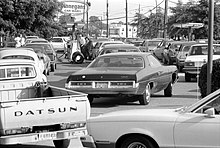
High prices on oil imports caused inflation to skyrocket during the Carter administration by as much as 12 percent per year. A widening trade deficit (a higher value on imports than on exports) also contributed to the inflation. To stress the need to conserve energy, Carter symbolically turned down the thermostat in the White House. Five laws passed in 1978, collectively known as the National Energy Plan, created a Department of Energy, allotted money from the U.S. budget to go to alternative energy research and created tax incentives to encourage domestic oil production and energy conservation.
In March 1979, nuclear power would also become part of the nation's energy crisis. Nuclear power, which involves splitting atoms and releasing energy while creating hazardous radioactive material, made up more than ten percent of the nation's electricity. A partial meltdown at Three Mile Island near Harrisburg, Pennsylvania, released radiation into the environment, alerting the nation to a potential hazard. Soon a protest movement against nuclear power spread, and while no further nuclear power plants were ordered in the United States, most already in operation continued in operation and most then under construction eventually went into operation.
Camp David Accords
[edit | edit source]
During the 1976 election, peace talks between the middle east, Israel, and the U.S. had stalled. The newly-elected president Carter moved to restart these talks, but when the right-wing Likud Party of Israel took control of the government in an electoral sweep, hopes for continued peace talks seemed all but lost. But Egyptian president Anwar Sadat, frustrated with the stalled process and motivated by prospects that the U.S. might help its anemic economy, decided to visit Israel, thereby recognizing its existence. Israel received Sadat's initiative, and the two countries soon went into bilateral (instead of the multilateral talks with the entire Arab world that Carter and Sadat had hoped for) talks, witnessed by the president at Camp David in Maryland.
The secret negotiations were heated and dramatic, and the two countries had threatened to walk on multiple occasions. Carter had personally appealed to Sadat and Israel leader Menachem Begin to stay in the talks. After twelve days, an agreement was reached, and on September 17th, 1978, the Camp David Accords were signed at the White House.
Hostage Crisis in Iran
[edit | edit source]In the '70s, Iran was a very strong Persian Gulf ally to the U.S. The Iranian Shah, Mohammed Reza Pahlavi, had built up a powerful military with U.S. help. Many Iranians complained about government corruption and the negative influence that the West had on Muslim values. In 1979 however, the shah was forced to leave the country after Islamic fundamentalists, (those who believe in very strict obedience to religious rules) led by the new Iranian ruler Ayatollah Khomeini, took control of the government.
Supported by the fundamentalists, Iranian students took over the U.S. embassy in Tehran, the capital of Iran, and took 52 U.S. citizens hostage. The United States was horrified. Negotiations to release the hostages failed and a rescue attempt in the country ended with the death of eight U.S. soldiers.
Though fear of an American-backed return by the Shah was the publicly stated reason, the true cause of the seizure was the long-standing U.S. support for the Shah's government. Reza Pahlavi ruled Iran from 1941 to 1979, with a brief period of exile in 1953 when he fled to Italy due to a power struggle with Prime Minister Mohammed Mossadegh. Because Mossadegh's policies and announcements created concern over access to Iranian oil, oil prices, and possible Soviet influence in Iran, the United States and British intelligence services aided Iranian military officers in a coup to overthrow the Prime Minister. After his return to power, the Shah established a very close alliance with the United States. The U.S. supplied weapons, training, and technical knowledge that aided the Shah in modernizing his country. However, the Shah ruled as a dictator, using SAVAK, his secret police, to terrorize his political enemies. The Shah was opposed by both the Marxist Tudeh Party, and by fundamentalist Islamic leaders who believed his policies and his reliance on the Americans were corrupting Iranian society.
The hostage crisis in Iran greatly lowered the public opinion of Carter, even though there was little else that Carter could do about it. The ordeal took a toll on his campaign for reelection in 1980; the public saw as a president who bargained with terrorists, and he lost to Ronald Reagan, 489 to 49 in the electoral college. An even greater disappointment for his failed campaign came in the last weeks of his term, in January 1981: with hard work, Carter secured the release of the hostages.
-
Iranian students at the US Embassy in Tehran.
-
Two of the hostages during the crisis.
-
Anti-Iranian protester in Washington DC, held November 1979.
Iran-Iraq War
[edit | edit source]
The Iran-Iraq War permanently altered the course of Iraqi history. It strained Iraqi political and social life, and led to severe economic dislocations. Viewed from a historical perspective, the outbreak of hostilities in 1980 was, in part, just another phase of the ancient Persian-Arab conflict that had been fueled by twentieth-century border disputes. Many observers, however, believe that Saddam Hussein's decision to invade Iran was a personal miscalculation based on ambition and a sense of vulnerability. Saddam Hussein, despite having made significant strides in forging an Iraqi nation-state, feared that Iran's new revolutionary leadership would threaten Iraq's delicate Sunni Shia balance and would exploit Iraq's geostrategic vulnerabilities--Iraq's minimal access to the Persian Gulf, for example. In this respect, Saddam Hussein's decision to invade Iran has historical precedent; the ancient rulers of Mesopotamia, fearing internal strife and foreign conquest, also engaged in frequent battles with the peoples of the highlands.
The Iran-Iraq War, also known as the Imposed War by Iraq, began when Iraq invaded Iran on 22 September 1980 following a long history of border disputes and fears of Shia insurgency among Iraq's long suppressed Shia majority influenced by Iran's Islamic revolution. Although Saddam's Iraq hoped to take advantage of revolutionary chaos in Iran and attacked without formal warning, they made only limited progress into Iran and within several months were repelled by the Iranians who regained virtually all lost territory by June 1982. For the next six years Iran was on the offensive. Despite several calls for a ceasefire by the United Nations Security Council, hostilities continued until 20 August 1988. The last prisoners of war were exchanged in 2003.
The war is noted for being very similar to World War I. Tactics used included trench warfare, manned machine-gun posts, bayonet charges, use of barbed wire, human wave attacks and Iraq's extensive use of chemical weapons (such as mustard gas) against Iranian troops and civilians as well as Iraqi Kurds.
Terrorism
[edit | edit source]At the turn of the 19th century, terrorism in the form of political assassination became a major global phenomenon. In the post-World War II years, other types of terrorism became strategies of choice for nationalist groups across the globe in their struggles for independence.
In predominantly agrarian societies, this terrorism took the form of guerrilla warfare, with China and Indochina as the classic examples. A number of these national political movements, which owed much of their success to violence, adopted a strategy in the war of semantics surrounding the use of violence. These newly created Third World Countries, as well as their brethren from the communist states, advanced the argument that their fight against colonial oppression was not terrorism but rather the hard work of dedicated freedom fighters.
A significant turning point in the history of terrorism was the formation of Hezbollah (Party of God), formed in 1982 in response to the Israeli invasion of Lebanon. This Lebanon-based radical Shi’a group takes its ideological inspiration from the Iranian revolution and the teachings of the Ayatollah Ruhollah Khomeini. Its members were not only interested in carrying out the goals of the revolution but were also concerned with the social conditions of their fellow Shiites throughout the Middle East. Hezbollah’s outreach in Lebanon during the 1980s solidified Lebanese Shiite support and helped spawn smaller terrorist groups, the most recognizable of which was the Islamic Jihad. [5]
Reagan
[edit | edit source]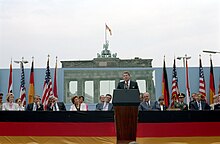
Reaganomics
[edit | edit source]
I have only one thing to say to the tax increasers. Go ahead, make my day.
In the years before and following Reagan's election, a conservative movement grew which complained that the government spent too much money and collected too many taxes. So, Reagan decided to cut taxes and spending. Reagan's policy of supply-side economics (increasing supply and services to stimulate the economy) soon became known simply as "Reaganomics." Reagan took over the worst economy since the Great Depression, one marred by Stagflation with unemployment of 13% and inflation of 17%. "Reaganomics" cut the top tax rate by half and lowered all other tax rates by a significant margin. The deals struck with the Democratic controlled congress caused an increase in spending and the decreased revenue from the tax cuts and smaller tax shelters could not cover the increases in spending on defense Reagan demanded. The largest increase in spending was defense in a plan to bankrupt the Soviet Union. By 1983, the economy began a steady growth, doubling tax revenue and increasing GDP by 2 trillion dollars. However critics of Reganomics note that the policies caused the national debt to increase significantly, as well as create significant income inequality.
The Reagan Revolution
[edit | edit source]During his Presidency, Ronald Reagan pursued policies that reflected his optimism in individual freedom, expanded the American economy, and contributed to the end of the Cold War. The "Reagan Revolution", as it came to be known, aimed to reinvigorate American morale, and reduce the people's reliance upon government
Air Traffic Strike
[edit | edit source]In 1981 Air Traffic Control workers began to strike, hoping to achieve better pay, better conditions, and less hours. Without air traffic control to guide planes, flights could not safely take place sending air travel to a halt. Furthermore, as federal employees, the air traffic controllers were violating the law by striking.
Regan was a former union leader and gave a grace period of 48 hours for strikers to quit striking and return to their duties at Air Traffic Control. While most striking workers did not return to work, a few did. This coupled with policy changes was able to restore about 50% of previous flight capacity during the strike.
Ultimately, Regan fired over 10,000 striking air traffic control workers, and banned them from future federal service, though some were later able to return. The strike was broken, the union dissolved, and it took about a decade to recover staffing of air traffic control positions to previous levels.
Sandra Day O'Connor Supreme Court nomination
[edit | edit source]
In 1980, Ronald Reagan promised to nominate the first woman to the Supreme Court should he be elected. Then, on July 3, 1981, Associate Justice Potter Stewart, who had been appointed by Dwight Eisenhower in 1958, retired. Reagan fulfilled his promise and nominated Sandra Day O'Connor, a judge on the Arizona Court of Appeals. The Senate confirmed her unanimously, and on September 25, 1981, she became the first woman to serve on the Supreme Court. She served as Associate Justice until January 31, 2006, when her successor, Samuel Alito, was confirmed.
Reagan nominated two other Justices to the Court. In 1986, he successfully nominated Antonin Scalia, and in 1988, he nominated Anthony Kennedy.
Defense
[edit | edit source]
Arms Race
[edit | edit source]As promised in his campaign, Reagan drastically increased military spending to a level of about $1.6 trillion in five years. This triggered a secondary arms race between the United States and the USSR, and relations between the two fell to levels not seen since the 60s. While Reagan favored drastically increasing spending on the military, the US confidence in full-scale ground war had been broken with the loss of Vietnam in the 70s. Because of this, Reagan favored funding trained insurgents to fight enemy governments instead of committing the army full-scale.
Grenada
[edit | edit source]The first major military conflict during Reagan's administration was 1983's Operation Urgent Fury, the invasion of the Caribbean island nation of Grenada. When the island was taken over by Marxist Bernard Coard in a coup, Reagan used the safety of 500 U.S. medical students working in the government as a pretext for the invasion. The new government was quickly overthrown in just four days, and served as a model for future conflicts.
Insurgencies
[edit | edit source]Reagan also, with the help of South Africa, funded insurgent groups fighting Soviet-backed regimes in the African nations of Mozambique and Angola. In Afghanistan, which had been invaded by the Soviet Union to the north, the U.S. government provided arms and humanitarian aid to mujahideen rebels fighting the Soviet-backed government. In 1985, Mikhail Gorbachev, a Communist party reformer, assumed leadership of Russia. Realizing that his Soviet troops were bogged down in a costly guerrilla war, and wanting to regain face with the international community, he announce in 1987 that the Soviet army would be withdrawing from the country, and had completely left by 1989.
Central America and Iran Contra
[edit | edit source]
Hostage takings in the middle east did not end after the 1979 Iran hostage crisis. In 1983, members of an Iranian militant organization were arrested for truck bombings in Kuwait, and an ally militant organization retaliated for the arrests by taking thirty hostages in Lebanon, six of whom were American. In order to free the hostages, the administration decided that it would secretly sell arms to Iran, one of America's greatest enemies, which was in the middle of a war with Iraq. Few countries were willing to supply Iran with weapons, and the United States sold the arms to Iran in the hopes that Iran would pressure the militants in Lebanon to free the hostages. This sale had the explicit approval of Reagan himself.
At the same time, a coup d'état in Nicaragua brought to power the socialist Sandinista government. The country had formerly been friendly territory for multinational corporations and a wealthy ruling class, and this resulted in a large poor class willing to hand power over to left-wing leaders. American interests in Central America seemed in jeopardy with the Sandinista government in power. When the CIA decided to conduct sabotage missions against the Sandinistas without congressional approval, the Republican senate angrily passed the Boland Amendment, which banned the funding of the anti-Sandinista Contra rebels by certain governmental agencies.
Because of this, a few in the Reagan administration decided to, possibly without the President's knowledge, use the proceeds from the secret weapons sale with Iran to secretly fund the Contra rebels in Nicaragua.
These dealings went on in violation of the Boland amendment, and in conflict with statements made by Reagan that he would not negotiate with terrorists. When a Lebanese magazine revealed the weapons-for-hostages dealings in 1986, scandal ensued. Reagan, with pressure from congressional Democrats and the media, created the Tower commission, led by former senator John Tower. The commission in the end laid most of the blame for the dealings on Reagan himself for not paying more attention and not having more direct control over many governmental agencies. The scandal itself raised many separation of power and presidential ethics questions, but Reagan emerged from its aftermath relatively unscathed. By the end of his second term, Reagan once again was registering positive approval ratings.
A few months ago I told the American people I did not trade arms for hostages. My heart and my best intentions still tell me that's true, but the facts and the evidence tell me it is not.
Changing Modern Society
[edit | edit source]A broad shift in values and attitudes took place in the U.S. between 1970 and 1990 as financial prosperity spread through American society. Across almost all social and economic groups, the trend was away from community and toward individualism. Aspects of the change included resistance to taxation and support for tax cuts; distrust of government and belief in privatization of public functions on the argument that the private sector could carry them out more effectively; decreased support for public assistance to low-income groups and demands that these groups improve their own economic standing; and a general decrease in the type of public citizen involvement that earlier generations had practiced during the middle decades of the 20th century. Politicians of both major parties hastened to follow these trends, with the Republicans in the lead under Reagan and the elder Bush, while the Democrats, seeing their broad base of voters increasingly drawn toward Republican positions, hastening to follow.
Pop Culture of the 70's and 80's
[edit | edit source]
Disco music became an icon of the late 1970's, with disco dancers wearing flamboyant and eye catching clothing. While disco had declined in popularity in America by the early 1980's, it had a large influence on emerging genres, such as electronic music and early hip hop.
Hip Hop emerged as a popular genre during the 1980s, with artists like Run-DMC, NWA, and the Beastie Boys enjoying popularity.
Pop artists such as Michael Jackson, Madonna, Bruce Springsteen, Prince, and others became immensely popular in America during the 80's.
Rock music, especially hard rock and related genres, also enjoyed a resurgence in the 1980's, with Metallica, Mötley Crüe, Queen, AC/DC, Kiss, Bon Jovi and other bands enjoying massive success in the United States.
MTV, a music television channel was launched in 1981. During the 1980's it broadcast music videos as well as related content and helped popularize music that was not being played on the radio.
Everyday life
[edit | edit source]By the late 1970's microwave ovens had become small enough and affordable enough to gain popularity in the household.[10]
During the 1980's, big box stores that combined both a grocery store and a department store under one roof became very popular.
Urban Problems
[edit | edit source]
Many people believed that despite large change in the 60’s and 70’s, race relations were taking a major step back during the Reagan administration. Reagan’s “New Right” caused a more apparent dividing of lines between religions and races. In 1988 national report claimed that blacks and whites were once again segregating. It pointed out the fact that more whites were living in nice suburban homes, while blacks and latinos lived in largely impoverished communities. Although there were more white people living in poverty, the percentage of people of color living in poverty was nearly three times that of whites. The living conditions of people of color living in poor urban communities continued to diminish and the neighborhoods became increasingly diminished as more struggled.
The war on drugs disproportionately affected minority communities, with unequal enforcement of the law leading to large numbers of African Americans behind bars for relatively trivial crimes.[11] As an example, Crack first made an impact in New York in 1985, striking poor urban neighborhoods. As more and more people became addicted to crack the business of drug dealing became more profitable and, therefore, more competitive. America saw a steep incline of drug crimes and gang related violence. In 1987 the death toll of gang related violence was at 387 in Los Angeles alone. Many of the victims were innocent bystanders. This increase in violence caused swift action. Many states enacted laws that gave mandatory prison sentences for crack possession. These laws made the punishment of holding 1 gram of crack the equivalent to having 100 grams of cocaine, the drug of choice for higher income whites. These laws are still considered some of the most blatantly racist in recent history. These laws, along with other crackdowns on people of color, caused a disproportion of black and latino convictions compared to people who were white. By 2000, young black men were more likely to have been arrested than to have graduated from college. Many see this as an obvious way to hold young black people down and keep them in impoverished, and even homeless, states.
As the Sun Belt as a whole grew, it accompanied a nationwide trend of migration out of cities and into suburbs. This migration was easier to accomplish with more accessible transportation brought by cars. The service sector of the economy grew along with this shift, at the expense of the shrinking manufacturing industry. Cities in the northern and midwestern "Rust Belt" were left with smaller populations and thus smaller tax bases, and large, poverty-stricken minorities; bankruptcy loomed for many northern cities. Additionally, old downtown areas of cities exhibited gentrification, a phenomenon in which affluent, young middle class citizens move into restored urban areas. This displaced the lower class and poor and contributed to one of the biggest problems of the mid-80s-- homelessness.
Conservative Movements
[edit | edit source]Neoconservatism The neoconservative movement grew in the 1960s & 1970s as a reaction to the growing antiwar counter-culture & liberal social programs like the Great Society. Neoconservatism advocated a very hawkish, interventionist foreign policy, and was less committed to cutting governmental spending than mainstream conservatism was. While the Reagan administration was the first to show hints of neoconservatism, the movement would not be in the political mainstream until the rise of think tanks like the American Enterprise Institute and the Project for the New American Century in the mid and late 90s. The culmination of this movement was the election of George W. Bush in 2000.
The Religious Right Evangelical Christians constitute the main constituency of what is often referred to as the “religious right.” Like neo-conservatism, evangelical Christianity (often referring to themselves as “born-again”) grew in the 1960s & 1970s. Organization such as the Moral Majority, founded in 1979 by televangelist Rev. Jerry Falwell, stressed “family values.”
Conservative Coalition Sharing membership and views on a variety of issues, neoconservatives and the religious right began to join forces in the late 1970s to form a conservative political coalition. The political platform of this coalition included moral opposition to drug use, pornography, and abortion, as well as opposition to the expensive liberal social programs of the 1960s and 1970s. The coalition also favored free-enterprise and foreign policy backed by a strong military.
The new coalition proved to be politically powerful, fueling a conservative victory in the national elections of 1980 when Republicans, supported by neoconservatives and the religious right, earned a majority in the U.S. Senate, while Ronald Reagan won in a landslide over Jimmy Carter in the presidential race. Specifically, California’s “Christian Voice” was influential in the 1980 election, swaying the vote in the South & the Midwest. The Rev. Jerry Falwell’s Moral Majority registered approximately 3 million voters from 1979 to 1980.
African Americans in Politics
[edit | edit source]By the 80s, African Americans saw a level of political empowerment and representation unseen during the course of the country's history. Mostly running as Democrats, the 80s saw the rise of many major black political players. Shirley Chisholm, a Brooklyn native, was elected to Congress in 1968, representing New York's 12th district. She was one of the founding members of the powerful Congressional Black Caucus, which would eventually constitute a large chunk of the Democratic caucus itself. Today, the powerful group boasts 43 members, all Democrats. Eventually Chisholm would be the first African American and first woman to make a serious (though unsuccessful) bid for the Presidency, but it would not be until Obama that one would get on the ticket in the general election.
In 1984, civil rights leader Jesse Jackson decided to make a bid for the Democratic nomination for the presidency and exceeded expectations, winning five southern primaries. Although he lost the nomination to Vice President Walter Mondale, Jackson was seen as a more credible candidate for the 1988 election. This proved to be an accurate prediction, with he and eventual nominee Michael Dukakis running neck and neck for the nomination. Briefly, Jackson was considered the frontrunner. Despite his loss, Jackson would remain politically active and would continue to push for progressive reform and civil rights for many minority groups, notably including homosexuals.
Other black politicians were appointed to positions of power as well. In 1967 President Lyndon B. Johnson appointed Thurgood Marshall to the supreme court. Marshall became the first African American to serve on the bench, and he did not retire until 1991. Clarence Thomas became the second black justice when he replaced Marshall that same year. As a general in the army, Colin Powell was appointed to the position of National Security Advisor, and was eventually elevated to the powerful position of Chairman of the Joint Chiefs of Staff. As a civilian, Colin Powell was appointed to the position of Secretary of State by George W. Bush in 2001. This was the first time a black person had been appointed Secretary of State and was the highest ranking position that any African American had held before.
Technology
[edit | edit source]In 1984 Motorola introduced the first mobile phone, the DynaTac to limited markets.[12]
NASA launched their first space shuttle in 1981, their first reusable spacecraft.[13]
"A computer on every desk"
[edit | edit source]This era saw the rise of the personal computer in common business use.[14]
-
An experimental Wind Turbine being tested at NASA's Plum Brook station in 1982.
-
A virtual reality headset from 1985.
-
The introduction of computers in common offices revolutionized how people access information.
References
[edit | edit source]- ↑ "History and cultural impact of the Interstate Highway system". glcp.uvm.edu. Retrieved 5 February 2021.
- ↑ Eschner, Kat. "Three Ways the Interstate System Changed America" (in en). Smithsonian Magazine. https://www.smithsonianmag.com/smart-news/three-ways-interstate-system-changed-america-180963815/.
- ↑ https://www.nytimes.com/2018/09/08/us/politics/nixon-ford-pardon-watergate.html
- ↑ "Super Review; United States History"
- ↑ Kushner, Harvey. Encyclopedia of Terrorism. California. Sage Publications Inc. 2003. Print.
- ↑ https://en.wikiquote.org/wiki/Ronald_Reagan#Second_term_of_office_(1985%E2%80%931989
- ↑ https://content.time.com/time/magazine/article/0,9171,141371,00.html
- ↑ https://en.wikiquote.org/wiki/Ronald_Reagan#1980s
- ↑ https://www.washingtonpost.com/archive/politics/1987/03/05/reagan-acknowledges-arms-for-hostages-swap/7a5cd7cc-a112-4283-94bd-7f730ad81901/
- ↑ https://spectrum.ieee.org/tech-history/space-age/a-brief-history-of-the-microwave-oven
- ↑ "The Drug War as Race War". academic.udayton.edu. Retrieved 26 December 2020.
- ↑ https://americanhistory.si.edu/collections/search/object/nmah_1191361
- ↑ https://www.nasa.gov/mission_pages/shuttle/flyout/index.html
- ↑ Reimer, Jeremy (15 December 2005). "Total share: 30 years of personal computer market share figures" (in en-us). Ars Technica. https://arstechnica.com/features/2005/12/total-share/4/.
